A long time coming: Eugene adopts River Road-Santa Clara Neighborhood Plan
After years of community involvement, collaboration and extensive evaluation, the city of Eugene and Lane County are taking action on the adoption of a new River Road-Santa Clara Neighborhood Plan.
Both the city and the county have spent years considering ways to incorporate such a plan into the the existing Eugene-Springfield Metropolitan Area General Plan. In meetings in late April, both entities finally stepped in, adopting the plan and paving the way for the city to approve neighborhood-specific land use code amendments.
Neighborhood boundaries and why adoption is happening
These communities are centered around River Road.
The neighborhood plan says the Santa Clara neighborhood occupies about 2,400 acres of the northernmost part of Eugene’s Urban Growth Boundary with physical boundaries including the Willamette River on the east side, Northwest Expressway to the west and Randy Papé Beltline Road to the south.
The River Road community is situated just south of Santa Clara, encompassing about 1,700 acres and bordering the Whiteaker Neighborhood to the south. The boundaries of this plan include a number of parcels across a variety of jurisdictions between the city of Eugene, Lane County and the Metro Plan Boundary. This variation means both the city of Eugene and Lane County needed to jointly adopt the neighborhood plan.
In 1987, the communities established the River Road-Santa Clara Urban Facilities Plan to govern land use and development in the area. In order to provide a long-term vision and guidance for the community, Eugene and Lane County formulated a plan in partnership with community organizations, residents and stakeholders.
The neighborhood plan is a forward-thinking, long-range policy document intended to establish a framework for land use and development going forward. As times change and legislation or circumstances shift, the plan may require amendments to keep up with changes in community values.
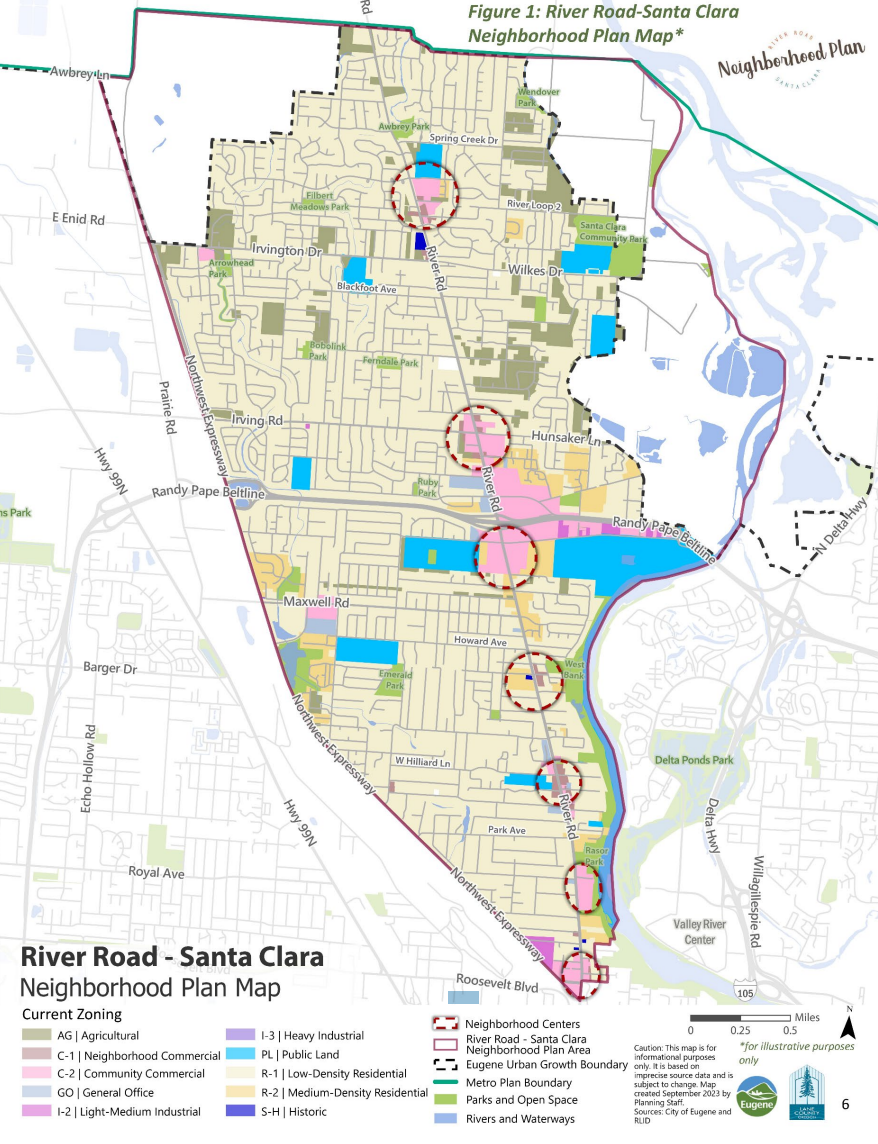
Over a decade of outreach, planning and implementing feedback
Back in early 2011, the River Road Community Organization and the Santa Clara Community Organization banded together and formed the Santa Clara-River Road Outreach and Learning project to begin outreach centered on identifying the priorities neighborhood residents had for future development in the area.
Their project culminated in a report and recommendations which included the formation of an advocacy group called the Santa Clara-River Road Implementation Planning Team. This work laid the foundation for the neighborhood plan.
Talks on the adoption of the River Road-Santa Clara Neighborhood Plan have been ongoing since the six-phase planning and adoption process began in the summer of 2017.
The first phase of generating this neighborhood plan started with outreach. This part of the process hinged on three objectives: to raise project awareness, promote community events and create opportunities for input.
Next came the Neighborhood Visioning and Neighborhood Priorities phases. These cycles focused on sharing information and requesting feedback to learn more about what residents value and how they wanted to see their community develop going forward. A Community Advisory Committee and Topic Area Working Groups met to share gathered information also with support from years of outreach done by the Santa Clara-River Road Outreach and Learning group and the Santa Clara-River Road Implementation Planning Team.
These groups identified five topic areas as emerging themes from their outreach, including: economic development, transportation, parks and natural resources, land use and community. This collective feedback allowed a more clear vision for the future of these neighborhoods to appear as the planning process continued.
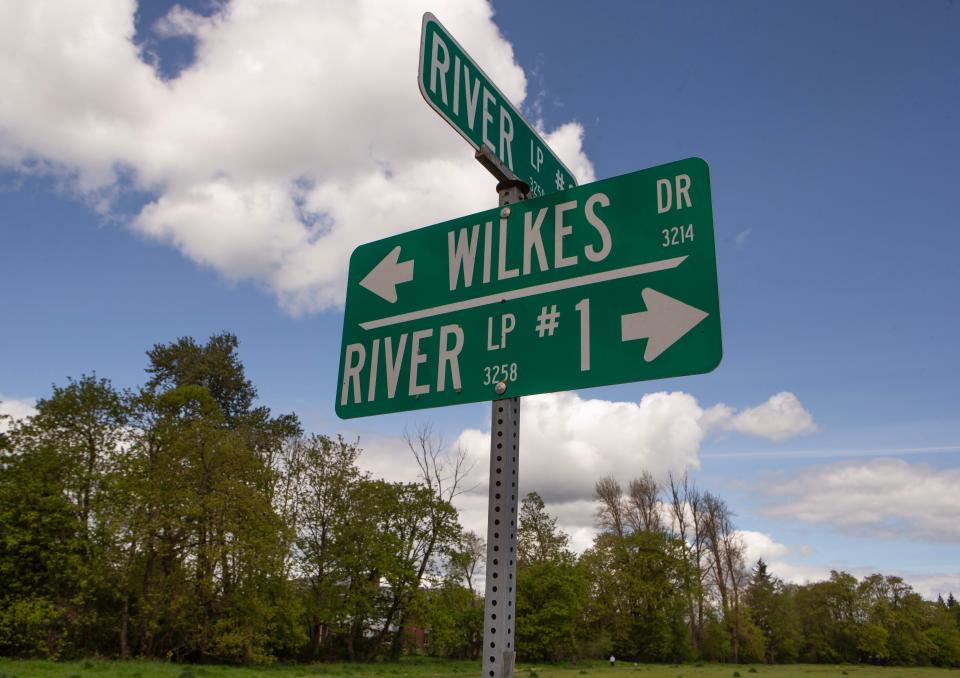
After visioning and priority establishment, the Policy Development Phase was full steam ahead. Working Group meetings were regularly held throughout this process to ensure that interested community members could continue to voice their opinions as policies for this plan were drafted.
The Eugene City Council approved the draft goals and policies set forth in May of 2019. This allowed the project to enter its next phase: Action Planning. This phase evaluated, prioritized and refined actions to implement the policies that had been drafted.
Two years later in May of 2021, the Eugene City Council and Lane County Board of Commissioners directed the project team to prepare a plan adoption package to be reviewed by the community. This started the final phase of the neighborhood plan — Adoption.
City staff provided a path to neighborhood adoption in 2022 that built upon the long-established plan that had been in development since 2017. This included refining neighborhood-specific land use codes applicable to properties within city limits. Impacts of legislation necessitated adaptations to the Plan as Eugene needed to revisit its middle housing ordinance and Climate-Friendly and Equitable Community policies changed parking requirements.
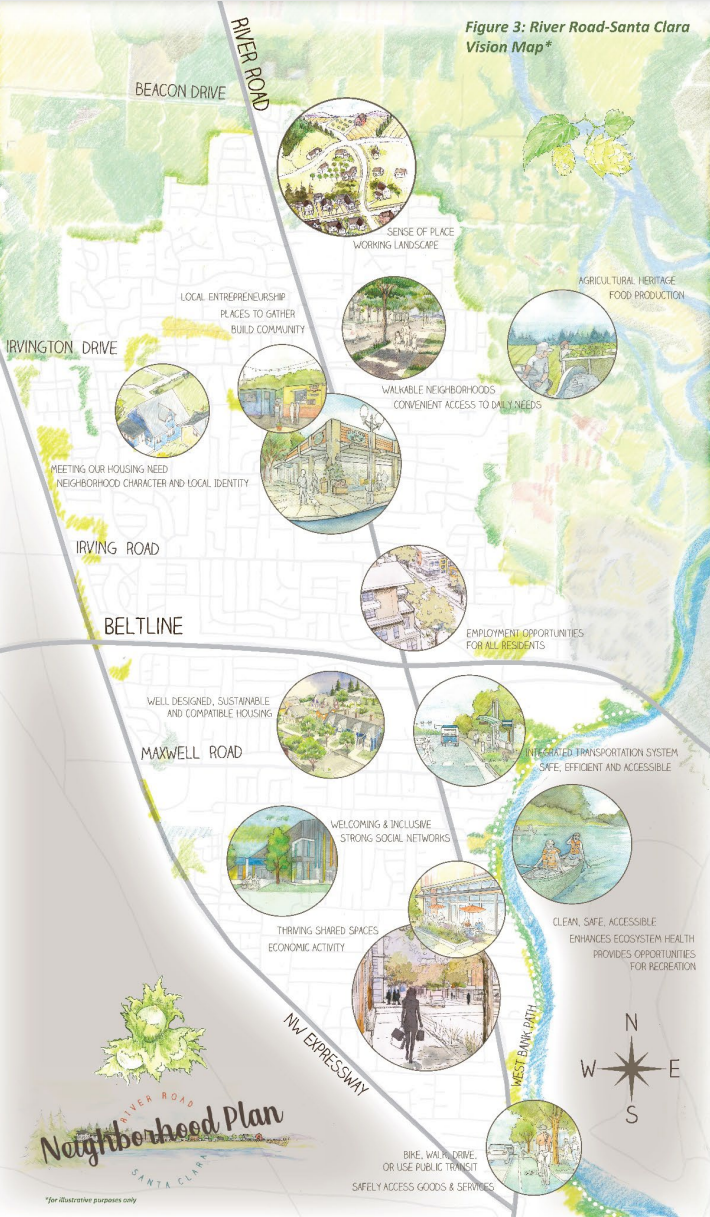
Principal Planner Terri Harding said over the years, adaptations have been necessary in order to navigate a shifting landscape and to balance the differences between what the city has codified for land uses and what the state legislature implements.
“The landscape has changed dramatically over the course of the planning process since 2017,” Harding said.
“It feels really good to be at a place where we’re poised to adopt the neighborhood plan but that’s not the end — that’s kind of the beginning of implementation so there will be ongoing work after it’s adopted.”
Elements of this adoption package include the neighborhood plan document and neighborhood-specific code amendments. The complementary Action Plan acts as a non-regulatory guidance document for the project outside of the adoption package. These code amendments were approved by the Community Advisory Committee for public feedback in March of 2023 and the final public hearing was held jointly between the Eugene City Council and the Lane County Board of Commissioners on March 12, 2024.
Code amendments as the "teeth" of the neighborhood plan
The proposed neighborhood-specific code amendments focus on a number of goals: to implement high-priority land use policies and actions, to use pedestrian-centric design to promote walkable neighborhoods and to shift away from auto-oriented land uses in alignment with city-wide climate and transportation goals. The majority of these code amendments apply to portions of the neighborhood primarily along River Road, with some exceptions, that make up the city’s community commercial zone.
Public feedback opposed the disallowance of auto-oriented businesses such as motor vehicle or watercraft sales and service and commercial storage units. This led to River Avenue, where numerous businesses of these types are already located, to be recommended to be ‘carved out’ from these land use codes in an effort not to negatively impact these existing businesses. These areas would become mixed-use areas within the community commercial zone.
These code amendments also include a reduction in the total allowable building height in the commercially zoned areas from 120 feet down to 65 feet, or about six stories tall if the bottom floor is utilized for commercial use with higher ceilings and the upper floors contain residential units.
Finally, an amendment to the low-density residential zone code would allow the display and sale of agricultural products grown off-site as a permitted use of that space. This would allow farmers, ranchers and home-growers to get together and sell products grown on their properties.
Harding said these amendments have been a vital piece of this plan since the project was started.
“From the beginning, it was very important to include some code amendments with the plan and put some teeth because the code is where the regulations live,” Harding said.
“It’s been important to people involved the whole way through that the plan be implemented as much as possible at the time of adoption.”
After undergoing some changes, Harding said these proposed code amendments act as a compromise between the city and the state’s land use requirements and needs.
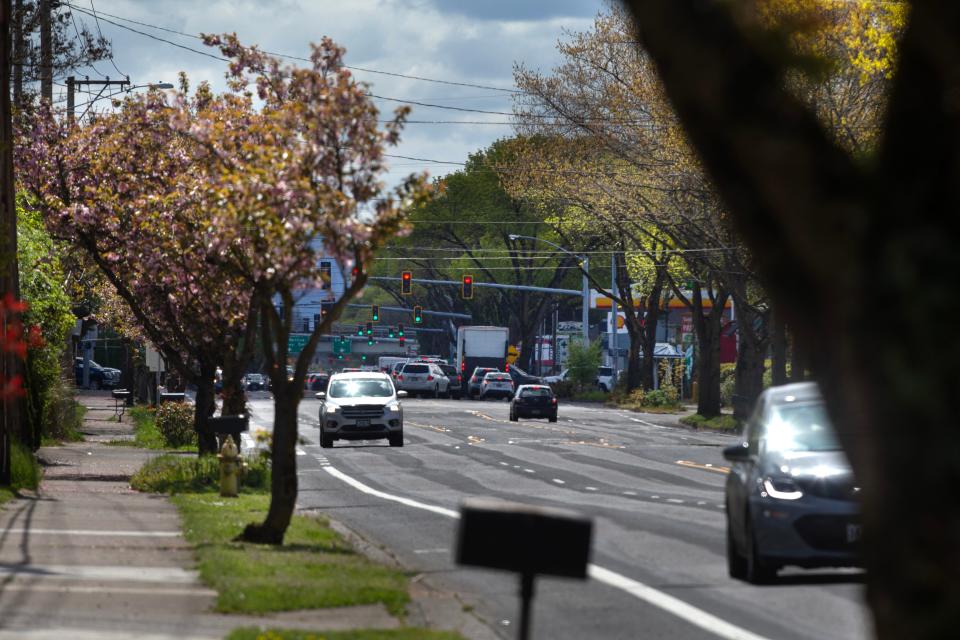
In meetings and work sessions with both Eugene City Councilors and Lane County Commissioners, elected officials expressed their appreciation for the hard work needed to get this neighborhood plan to the point where it can be adopted. At the same time, they echoed concerns expressed by colleagues and constituents regarding these code amendments.
At a City Council work session in February, Eugene Ward 5 City Councilor Mike Clark said the work done in this adoption process achieves the unmet goal of his predecessor, Gary Papè, in trying to see the Santa Clara Community Park constructed and opened to the public. Construction on this park is ongoing. Despite these long-term goals being achieved, Clark said he still has concerns about the code amendments.
“I know representing parts of Santa Clara how long this has been in process. It predates my term on council, some of the work around the neighborhood plan,” Clark said.
“My concern with the code amendments is that we may not be understanding some of the things that may be coming down the road, especially from the state legislature, in the next year or two. I’m not sure that’s what I could call ‘fully-baked’ yet, that we’re ready for those portions but when it comes to the neighborhood plan itself and the policy statements, I’m entirely in favor.”
At the Council's April 22 regular meeting, Clark said he is "happy to be supportive of the vision and of all of the neighbors whose volunteer efforts produced this plan," but that his concerns around the code amendments still stand. He was the only vote against the ordinance for code amendments.
"There are new issues coming in 2026 with CFEC that we will open all of this back up again and could do it, in my estimation, the right way," Clark said.
"The reason it’s not the right way is because it’s my opinion that the findings for these code amendments clearly do not import and comply and are consistent with the Metro Plan."
In February, Ward 7 Councilor Lyndsie Leech shared concerns relevant to code amendments, noting how changing legislation and policies have impacted the neighborhood planning process.
“I know we can hear, probably a collective sigh of relief all down this whole corridor after all these years of work on this plan and having to pivot so many times with all of the different state codes that have come along — middle housing, and CFEC and all of the different ways we’ve had to switch gears a little bit with this plan and how our neighborhood planning process in general is changing because of that,” Leech said.
At the April Council meeting, Leech emphasized her support for the neighborhood plan and code amendments.
"In honor of all of those people and all of the staff time, I think we need to pass this today and we can always readjust later on down the road if in 2026 like Councilor Clark has mentioned, things become problematic, we can always make adjustments," Leech said.
"For now, I really encourage us to move forward with this."
The City Council passed both the adoption of the River Road-Santa Clara Neighborhood Plan and the code amendments at its April 22 meeting. Councilors also passed a motion setting up a work session to be held before Jan. 1, 2025, to further discuss options to address parking concerns and voluntary annexation in the area.
Lane County District 4 Commissioner Pat Farr said in a commission meeting Feb. 27 that this years-long process has been impacted in a number of ways and that issues like a lack of parking for residencies causing an overflow of street parking and a need to increase pedestrian safety still need to be addressed in this neighborhood.
“When I was a state rep decades ago, I represented Santa Clara and then in my first tenure as a commissioner, I represented River Road. Now, I don’t represent any of those neighborhoods. That being said, I’ve been a part of the process all along and it has evolved,” Farr said.
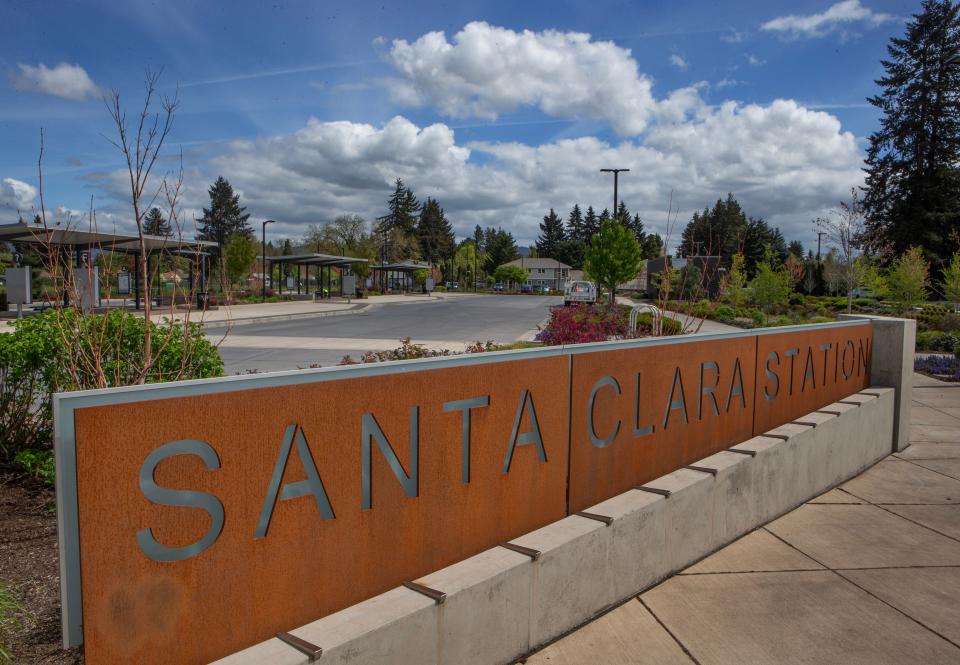
“The plans we were looking at 20 years ago have evolved pretty significantly to what we see today and what you’ve come through with the River Road and Santa Clara neighbors.”
Upon the carrying of the commission's motion to approve the ordinances set before the commission on April 23, Farr said the board will continue hearing concerns about on-street parking as development continues in the River Road and Santa Clara areas.
Harding said this plan does not lead with conversation around annexation and that this plan can’t solve issues brought up around annexation or service provisions, as services are managed through Intergovernmental Agreements and Memorandums of Understanding. She also said concerns about issues like inadequate or overflow parking are common in discussions revolving around urban development.
“A lot of the issues that did come up at the work session or previous work sessions happen everywhere, like parking concerns with new development or unimproved property next to improved property,” Harding said.
“There are just urban growth and development issues everywhere but some of them are exacerbated in this area because there is this checkerboard pattern and more challenges with figuring it out in this area.”
Implementing long-term communication and collaboration
Harding said once this plan is adopted that a deep breath and celebrations are in order to thank the dedicated volunteers and dozens of staff members who have poured into this neighborhood plan.
Once adopted, the city hopes to implement an annual collaborative conversation with the two neighborhood organizations in order to follow up on the project and ensure a clear form of communication between the city and the neighborhoods.
“It’s certainly a conclusion of some parts,” Harding said.
“I’m not saying it’s a ‘nothing burger’ because it’s a big deal, it’s a big milestone to get the neighborhood plan adopted but if we just adopt it and forget about it, we will have failed.”
Even though the neighborhoods and city staff have recently seen this plan adopted after years of generating and drafting plans, new projects are already in the works to provide more amenities to the River Road-Santa Clara area, including the new Santa Clara Community Park, which broke ground on phase one of development earlier this month.
Jon Belcher and Kate Perle both worked as co-chairs for the Community Advisory Committee (CAC) and helped voice the input of their neighbors throughout the process of creating this neighborhood plan. They both joined in on the planning process in 2017 and have dedicated time and energy to making sure that the River Road-Santa Clara Neighborhood Plan is one that their neighbors were closely involved in, ensuring the plan was one generated collaboratively and not a plan that was done to or for them.
Belcher, who is also a co-chair of the River Road Community Organization, said the neighborhood organizations and CAC worked as the main point of contact for the city and county on decision-making for the plan. He said this plan will operate as a blueprint for how neighborhood planning processes are conducted going forward and that the way this process was carried out operated differently than former neighborhood planning procedures in the amount of community involvement.
"It’s sort of the mantra of ’failing to plan is planning to fail,’" Belcher said.
"Even worse is when you let someone else do it for you."
Perle, who is also the chair of the Santa Clara Neighborhood Organization, said in order to succeed in developing this plan in a way that supports the residents most directly impacted by it, the neighborhoods needed to lead the decision-making process. For residents of these neighborhoods, Perle said it was vital that they be allowed to direct their own futures.
"Change will come. The choice is to wait and react to changes or to take a leading step in guiding how growth and development is going to change our community for the future," Perle said.
"We figured that the best course of action for River Road and Santa Clara was to create the bumpers, the guide, for how growth and development were going to change our neighborhood over the next three decades instead of waiting for somebody else to make those choices for us and then try to either oppose those choices or modify those choices or ratify those choices. We’d be better off being in the driver’s seat and that’s how this project started and that’s how we continued to operate the whole way."
The years it's taken to develop and finalize the adoption of this neighborhood plan have allowed for thorough discussion and community input. In order to ensure that this plan continues to serve the folks most impacted by it, the city has committed to annual conversations with these stakeholders, allowing for the neighborhoods to remain involved in the development around them.
"The plan isn’t finished, the plan is adopted which means that now we are stepping up to the line and getting ready to start the race. The race is really advocating for everything in our action plan, getting people involved, finding funding, finding workers and finding all of the things we need to make it happen," Perle said.
"All we’ve done so far is put out the wish list. Now to actually manifest it, it’s going to be the next 20 years of work."
For Belcher, this means that the communities take some time to refocus on the actions they'd like to see taken in order to manifest this neighborhood plan.
"We need to celebrate our victory but recognize that this has just opened the door for us," Belcher said.
Top of mind for both of these neighborhood organization leaders is gratitude for the countless individuals and groups involved in seeing this project go from an idea to an adopted plan that provides a blueprint and foundation for other neighborhood planning processes moving forward. Neighborhood members integral to the community outreach and plan development processes include Carleen Reilly, of the River Road neighborhood, who passed away in January of this year, and Jerry Finigan, of the Santa Clara neighborhood.
"I just feel like it was a pretty impressive and dedicated group of individuals that managed to pull this rabbit out of a hat," Perle said.
"Now, we can take a deep breath and then look at it through the lens of, ‘how do we not waste that effort and instead parlay it into the best possible manifestation on the ground?’"
Hannarose McGuinness is The Register-Guard’s growth and development reporter. Contact her at 541-844-9859 or hmcguinness@registerguard.com
This article originally appeared on Register-Guard: Years-long process of formulating neighborhood plan leads to adoption

